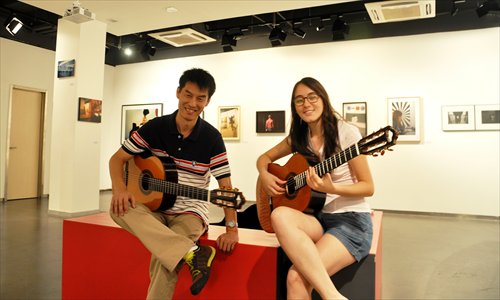The red guitar?
The only place most Chinese people see a guitar is on a street corner, on in a dimly lit, smoky bar.
But this virtuoso instrument can also be appreciated inside a concert hall where classical compositions have long been associated with the world's most popular stringed instrument.
"In fact, there have been many classical compositions written specifically with the guitar in mind," classical guitarist Gao Yi told the Global Times. "And the classical guitar can be a solo instrument or be a part of a larger ensemble." Gao has been playing solo guitar in China since the 1990s.

Many compositions
From September 6 to the end of this year, Gao and Erika Morant, a young classical guitarist from Medellín, Columbia, will hold a series of lectures and salons on the classical guitar at the cultural department of the Consulate General of Spain in Shanghai on Anfu Road. The series is being staged to coincide with the annual Shanghai International Instrument Exhibition on October 9.
"The main purpose of this event is to popularize education of the classical guitar among the Chinese because not so many people are familiar with it here. Many people imagine the guitar is only an accompaniment for singers, but in fact there have been thousands of compositions written specifically for classical guitar," Gao said.
He told the Global Times that the classical guitar first appeared in China in the 1960s. "However, during the Cultural Revolution (1966-76), playing of the guitar was prohibited. Many instruments were burnt on bonfires, and some of the players were thrown into prison and accused of 'rogue behavior,'" said Gao.
It wasn't until the 1980s that the guitar reappeared in China and began to arouse interest among local people. "However, its appeal was still limited in that it was only regarded as an accompaniment to singers. And in truth, that is still largely the situation today," he added.
According to Gao, a university major in classical guitar was first launched by the Central Conservatory of Music in Beijing in 1996. Before that, there had only ever been two short training courses in classical guitar held by the conservatory, both co-sponsored by the Spanish and Chinese governments.
"Today, there are some 10 majors in classical guitar run by professional music institutions across the country," Gao said.
After graduating from the University of Antioquia in Medellín as a classical guitar major, Morant first came to Shanghai last year and now is studying for a master's degree at the Shanghai Conservatory of Music.
She told the Global Times that, after coming to China, she quickly realized that most Chinese people know very little about its role as a classical instrument.
"Professional music institutions here have very few, if any, guitar teachers and not many Chinese parents would ever think of sending their children to guitar lessons," said Morant.
She added that in her native Columbia and surrounding Latin American countries, as well as Spain, the guitar is a hugely popular instrument. "For many youngsters who want to learn guitar, their first teacher is often their grandfather or grandmother," said Morant.
Huge impact
She told the Global Times that the classical guitar is also often referred to as "Spanish guitar," because of the number of Spanish-born guitar makers and musicians who have made such a huge impact on the history of the instrument.
According to Morant, two legendary names in this regard are Francisco Tárrega, born in 1852 in Villarreal, and who is widely regarded as "the Father of Guitar," and Andrés Segovia born in Jaén in 1893.
Tarrega wrote many compositions specifically for guitar and the popularity of these works improved the status of the instrument in the 19th century, not just in Spain but across the whole of Europe.
"And one of Segovia's great contributions was that he increased the sound volume of the guitar by changing the material used in the strings from catgut to nylon," Morant added.
Gao told the Global Times that, as a highly skilled soloist, Segovia gave many guitar recitals around the world during the 1930s and 1940s.
"He even came to Shanghai in 1937. But unfortunately he was unable to set up a concert because, at that time, nobody even thought the guitar as worthy of being played in a concert, and he received very little public support," said Gao. "However, Segovia's travels helped to foster the reputation of classical guitar in other Asian countries at the time, such as Japan and South Korea."